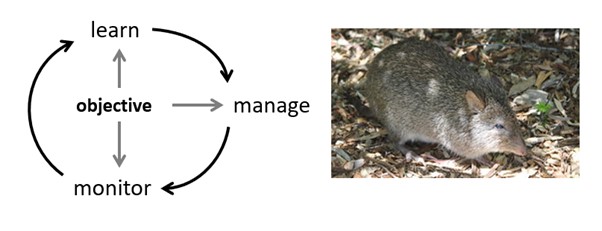|
Getting your Trinity Audio player ready...
|
Author Sam Nicol describes his team’s latest research developing a new model to help managers easily identify and employ adaptive management interventions to protect threatened species.
Adaptive management—what’s the problem?
Adaptive management has been the coolest thing in conservation for almost 40 years – everyone wants to do it. Way back in the ‘80s, the elegant seminal formulations by Hollings and Walters proposed that conservation and resource management were problems that could be optimised. After setting an objective, adaptive managers could ‘learn by doing’, with all their actions and monitoring continuously contributing to making better decisions to achieve their goal.
However, despite many impressive advances, this immensely appealing concept has largely proven difficult to translate into practice (although notable examples exist). The reasons for this ‘implementation gap’ are many, but among them are the data-hungry needs of the models, the inaccessibility of the maths required, and the tendency to develop bespoke solutions with high implementation costs for problem-specific returns.
All of these factors also translate into a large expense associated with implanting adaptive management, particularly if a full controlled experimental design is required for each species. To make optimal adaptive management more accessible, there is a need to make it simpler and cheaper.
A solution – keep it simple and make it easy!
In our recent paper, we tackle some of these barriers to uptake.
Starting from design principles of simplicity, generality and interpretability, we devised a general adaptive management formulation to model the interactions between a species and its main threat. We modelled the problem with a very minimal number of states to make the solution fast and to maintain generality across different applications. Keeping the number of states small also requires less information to parameterize the models, which is great for expert-elicited models.
To further help with elicitation and interpretation, we built a Shiny app in R where experts or other users can play around with different model parameterisations to check their intuition.
With help from the New South Wales Saving our Species program and some wonderful species experts, we applied our approach to a case study of fox predation impacts on the long-footed potoroo, a threatened marsupial. In this case, it turned out that the optimal strategy was robust to uncertainty and there was low value of information to be gained by resolving it. More simply, we already know the best management policy and don’t need to learn by doing.
This highlights one of the values of a rapid approach – it is much better to be able to rapidly test a question than to spend years developing a complex approach only to find out that we asked the wrong question.
What’s next?
The big idea of our paper is that we need to generalise adaptive management models and make them accessible to users. We propose using simple archetypical models that are broadly applicable.
We developed one such model (one species with one main threat), but we also envision that a library of several other model archetypes could be created (e.g. multiple threats to a single species; optimal harvesting problems; epidemiological problems). With the broad uptake of R and the low cost to develop Shiny apps, we can make these general adaptive models readily available for scenarios which are applicable to many threatened species.

There are thousands of threatened species which could benefit from structured adaptive management problems, and we can’t develop customised models and solutions for them all. Although there are many species, they often share common threats which can be treated in the same way by modellers.
We hope that by exploiting these commonalities, we can lower the cost of entry into adaptive management for conservation managers and finally overcome the implementation gap.
Read the full article: “A general optimal adaptive framework for managing a threatened species” in Issue 3:4 of Ecological Solutions and Evidence.

